ASUS Maximus VII Impact Review: Premium Gaming Z97 in mini-ITX
by Ian Cutress on December 9, 2014 10:00 AM ESTMany thanks to...
We must thank the following companies for kindly providing hardware for our test bed:
Thank you to OCZ for providing us with PSUs and SSDs.
Thank you to G.Skill for providing us with memory.
Thank you to Corsair for providing us with an AX1200i PSU and a Corsair H80i CLC.
Thank you to MSI for providing us with the NVIDIA GTX 770 Lightning GPUs.
Thank you to Rosewill for providing us with PSUs and RK-9100 keyboards.
Thank you to ASRock for providing us with some IO testing kit.
Thank you to Cooler Master for providing us with Nepton 140XL CLCs.
Test Setup
| Test Setup | |
| Processor | Intel Core i7-4770K ES 4 Cores, 8 Threads, 3.5 GHz (3.9 GHz Turbo) |
| Motherboard | ASUS Maximus VII Impact |
| Cooling | Cooler Master Nepton 140XL Corsair H80i Thermaltake TRUE Copper |
| Power Supply | OCZ 1250W Gold ZX Series Corsair AX1200i Platinum PSU |
| Memory | G.Skill RipjawsZ 4x4 GB DDR3-1600 9-11-9 Kit |
| Memory Settings | 1600 9-11-9-27 1T tRFC 240 |
| Video Cards | MSI GTX 770 Lightning 2GB (1150/1202 Boost) |
| Video Drivers | NVIDIA Drivers 337 |
| Hard Drive | OCZ Vertex 3 256GB |
| Optical Drive | LG GH22NS50 |
| Case | Open Test Bed |
| Operating System | Windows 7 64-bit SP1 |
| USB 2/3 Testing | OCZ Vertex 3 240GB with SATA->USB Adaptor |
System Benchmarks
Power Consumption
Power consumption was tested on the system while in a single MSI GTX 770 Lightning GPU configuration with a wall meter connected to the OCZ 1250W power supply. This power supply is Gold rated, and as I am in the UK on a 230-240 V supply, leads to ~75% efficiency > 50W, and 90%+ efficiency at 250W, suitable for both idle and multi-GPU loading. This method of power reading allows us to compare the power management of the UEFI and the board to supply components with power under load, and includes typical PSU losses due to efficiency. These are the real world values that consumers may expect from a typical system (minus the monitor) using this motherboard.
While this method for power measurement may not be ideal, and you feel these numbers are not representative due to the high wattage power supply being used (we use the same PSU to remain consistent over a series of reviews, and the fact that some boards on our test bed get tested with three or four high powered GPUs), the important point to take away is the relationship between the numbers. These boards are all under the same conditions, and thus the differences between them should be easy to spot.
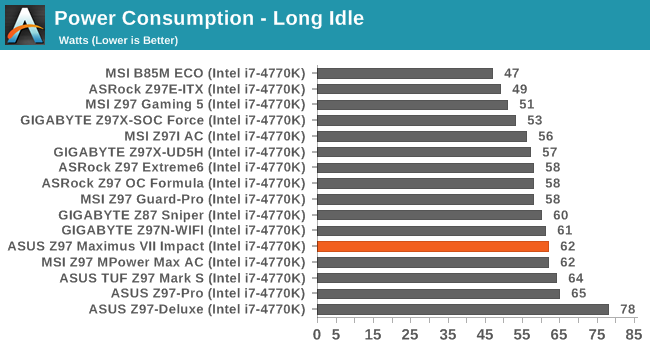
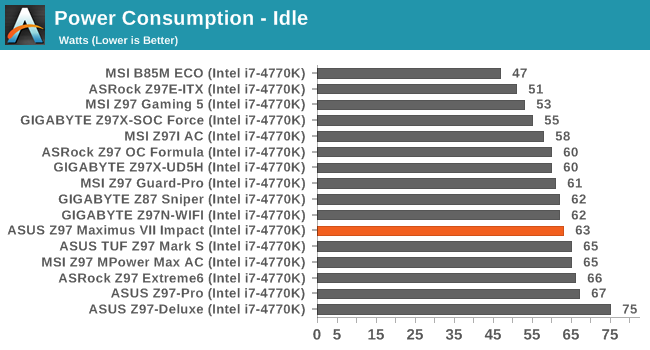
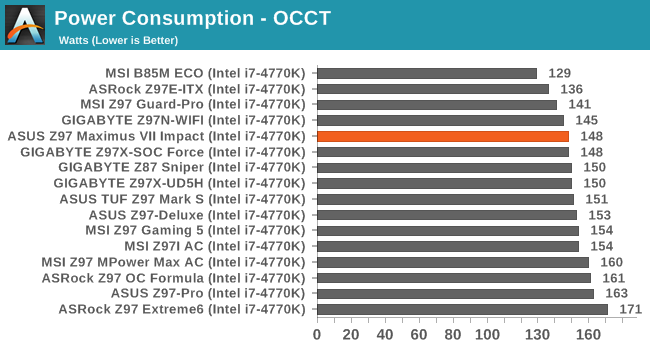
Peak power consumption was just under the 150W mark, resulting in a low idle-to-peak variation of 86W. Idle numbers were actually quite high, though it is hard to pin down if this is down to general design choices or the daughterboard design resulting in small but extra losses.
Windows 7 POST Time
Different motherboards have different POST sequences before an operating system is initialized. A lot of this is dependent on the board itself, and POST boot time is determined by the controllers on board (and the sequence of how those extras are organized). As part of our testing, we look at the POST Boot Time using a stopwatch. This is the time from pressing the ON button on the computer to when Windows 7 starts loading. (We discount Windows loading as it is highly variable given Windows specific features.)
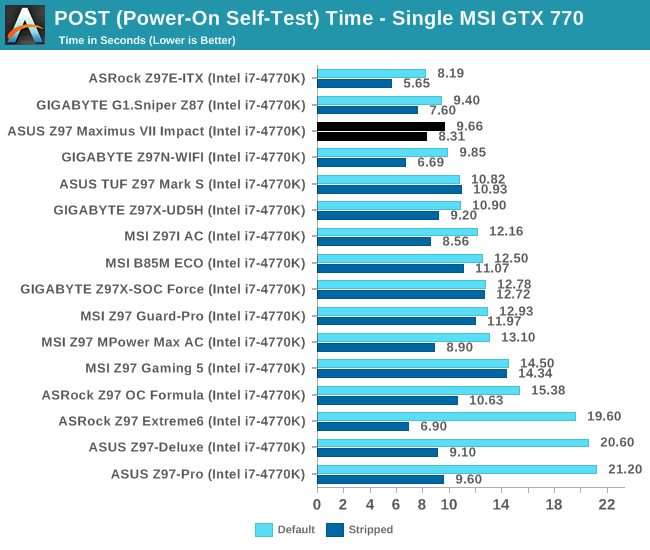
Less than 10 seconds POST time is a good benchmark in which the Impact did well.
Rightmark Audio Analyzer 6.2.5
Rightmark:AA indicates how well the sound system is built and isolated from electrical interference (either internally or externally). For this test we connect the Line Out to the Line In using a short six inch 3.5mm to 3.5mm high-quality jack, turn the OS speaker volume to 100%, and run the Rightmark default test suite at 192 kHz, 24-bit. The OS is tuned to 192 kHz/24-bit input and output, and the Line-In volume is adjusted until we have the best RMAA value in the mini-pretest. We look specifically at the Dynamic Range of the audio codec used on board, as well as the Total Harmonic Distortion + Noise.
Unfortunately our audio results were a little off due to a defect in our sound system. As shown in the image above, we had an odd situation where less than 300 Hz the THD+N response was some 30 dB different to what we would expect. ASUS sent us some results from a board in their offices that showed normal response, indicating that perhaps mine had a slight issue.
USB Backup
For this benchmark, we transfer a set size of files from the SSD to the USB drive using DiskBench, which monitors the time taken to transfer. The files transferred are a 1.52 GB set of 2867 files across 320 folders – 95% of these files are small typical website files, and the rest (90% of the size) are small 30 second HD videos. In an update to pre-Z87 testing, we also run MaxCPU to load up one of the threads during the test which improves general performance up to 15% by causing all the internal pathways to run at full speed.

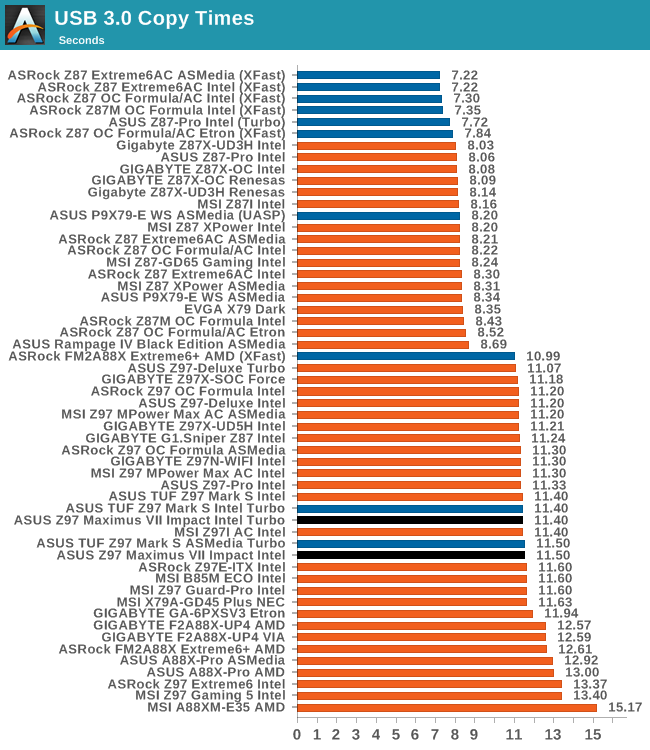
USB 2.0 performance on the Impact was slightly better than our previous Z97 results, with USB 3.0 coming in ballpark.
DPC Latency
Deferred Procedure Call latency is a way in which Windows handles interrupt servicing. In order to wait for a processor to acknowledge the request, the system will queue all interrupt requests by priority. Critical interrupts will be handled as soon as possible, whereas lesser priority requests such as audio will be further down the line. If the audio device requires data, it will have to wait until the request is processed before the buffer is filled.
If the device drivers of higher priority components in a system are poorly implemented, this can cause delays in request scheduling and process time. This can lead to an empty audio buffer and characteristic audible pauses, pops and clicks. The DPC latency checker measures how much time is taken processing DPCs from driver invocation. The lower the value will result in better audio transfer at smaller buffer sizes. Results are measured in microseconds.
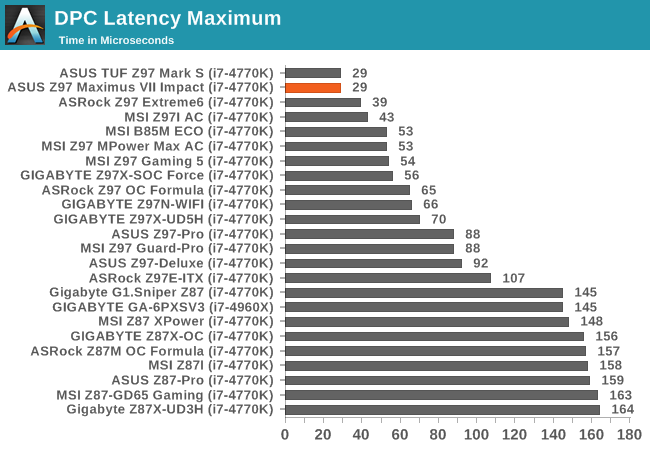
One of the super positive results to come from this review is the DPC Latency. The Impact came in at 29 microseconds, the same as the ASUS TUF Z97 Mark S, matching the best ever result.


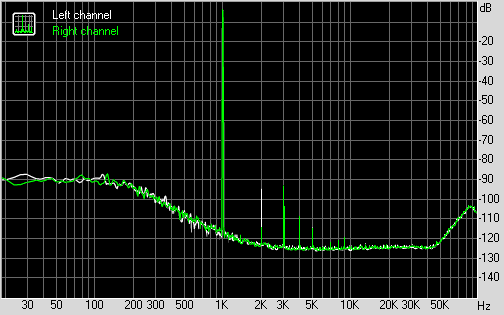








41 Comments
View All Comments
Gigaplex - Tuesday, December 9, 2014 - link
"However due to the detachable audio card, replacing it doesn't require a completely new motherboard."Unless they actually sell the audio cards separately, you're likely to need to replace the whole package anyway.
Laststop311 - Wednesday, December 10, 2014 - link
You could find a used mobo for cheap on ebay by the time an audio card dued and just buy it for the audio card. Probably even be able to find boards that aren't working correctly with a salvageable audio card.Laststop311 - Wednesday, December 10, 2014 - link
died*just4U - Tuesday, December 9, 2014 - link
Tough call between this one and MSI's Z97i gaming ac. I'd say the two sit atop the heap as far as quality goes. I am actually not bothered by the price of either.. as your trying to go small but that doesn't necessarily mean a budget build. Curious what Gigabyte has in their pipeline.. but all in all I like what I see from Asus here.. especially where the power connectors are. Nice review Ian.Laststop311 - Wednesday, December 10, 2014 - link
It's really not a tough call Asus are the ones who started using separate boards for the power delivery and they have the experience and know how to do it best. Before Asus did that manufacturers were just using rly skimpy cut back heavily power delivery so it would fit on the board. Rather than go that route asus pioneered using a separate board so they had the room to make a beefy power delivery design and not have to sacrifice any OC potential compared to a larger board. Also as this review shows the bios and the software that controls asus motherboards is more advanced and more technically capable than MSI's.The pcie-3.0 x4 slot for m2 ssd's is also huge. That's an incredible 4GB/sec of bandwidth. This also allows you to keep the build incredibly tiny as you can attach no storage drives other than the m2 card such as this one:
"The Samsung SM951 is expected to be NVMe compatible, and will be capable of up to 1,600/1,000 MB/s sequential reads/writes and 130K/100K IOPS 4K random reads/writes – slightly faster than the XP941 rated for 1,400 MB/s sequential reads. The drive is also NVMe low power (L1.2) certified and is rated to draw <10mW power at idle (probably DevSleep mode). Available in capacities up to 1TB"
So even with no 2.5" or 3.5" drives you can still have 1TB of storage space on a drive with 1600/1000 speeds 3x-4x faster than anything used now. This board is just the perfect starting point for an ultimate incredibly fast small form factor pc. With no 2.5" or 3.5" drives, no optical or any other outside media drive you only need enough space for a PSU (a small 600 watt 80+ gold silverstone sfx sized psu) your graphics card (a small mini itx sized gtx 970) and then since no optical or any other drives u can fit a nice 240/280mm rad on the top and you can overclock like you are inside a regular large tower.
You can build a really neat really powerful tiny mini PC and by using this board you end up with more power and features than even many ATX sized boards. This board allows you to go small without making a single real sacrifice and in most cases adds more features then many big boards. You can't go wrong with this board. Hell its even a nice board to choose even if you can fit an atx sized board. At 240 this board has the same features as atx sized boars that are 275+
Laststop311 - Wednesday, December 10, 2014 - link
Also since this is a mini itx board and haswell cpu's only have 20 pci-e lanes coming directly off it you can freely use the 4x m2 ssd slot and since there is only 1 pci-e expansion slot you don't have to worry about making any sacrifices since you are using the m2 slot you still get full 16x gpu bandwidth (even tho 8x is basically identical performance still nice to eek out that 1% better on 16x.)just4U - Wednesday, December 10, 2014 - link
No .. it's still a tough call. I like both boards. :)dwade123 - Wednesday, December 10, 2014 - link
Stupid price. I rather get an x99 setup if i want to spend that much on a freaking motherboard.krazy_olie - Wednesday, December 10, 2014 - link
No x99 itx motherboard exists....krazy_olie - Wednesday, December 10, 2014 - link
Picked up this board in a bundle.The fan headers is a bit of a stupid situation, on the plus side you get 3 headers in 2 locations. on the downside these aren't pwm. I have a fan plugged in to cha_fan3 and it runs at full whack and can't reduce the speed. I need to try channel 1 to see if it's a problem generally or just with the coolhub.
Worth noting that the z97i plus actually has pwm headers with fan xpert 3